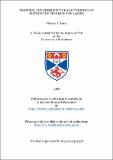Temporal and frequency characteristics of distributed feedback dye lasers
Abstract
Previous studies of distributed feedback dye lasers (DFDL's) have identified that the linewidth of the device scales, to a first approximation, with the level of pumping employed. A more recent development is that the DFDL can be used to produce single ultrashort pulses. To produce such pulses the main requirement is that the laser is operated close to its threshold. An apparent contradiction exists here since, by lowering the pump power to achieve narrow linewidth operation, the near threshold region must be avoided since pulsing operation acts to increase the linewidth (to at least the Fourier transform of the pulse duration). This thesis further investigates the mechanisms which contribute to the temporal and linewidth properties of the laser. It is identified that by judicious choice of operating conditions a regime exists where the DFDL may be operated with a linewidth approaching that of the transform limit for the nanosecond pulse durations involved. After introducing the different types of distributed feedback lasers the thesis first reviews previously understood DFDL behaviour. Different DFDL geometries are considered with a view to their particular temporal and linewidth properties. A strategy for the development of a narrow linewidth DFDL is presented. The experimental laser system is described detailing the operation and characteristics of the frequency doubled Q switched Nd:YAG pump laser and the two different DFDL geometries. A high resolution computer aided interferometry (CAIN) system is described which provided single shot linewidth measurements. This system was used extensively in the experiments reported. DFDL linewidth is seen to depend on the thermo-optical properties of the dye's host solvent and as such a full characterization of commonly used solvents is presented. The temporal behaviour of the laser is considered theoretically with the aid of a coupled rate equation model which describes the interplay between the population inversion and the cavity photon flux. The model is used to predict short (picosecond) and smooth (nanosecond) pulse operation of the laser. Finally, a description of and the results obtained from various experimental investigations into the DFDL are presented. Temporal analysis, using a streak camera, revealed that, as expected, under certain circumstances multiple pulsing of picosecond duration could occur. Different conditions however, lead to narrow linewidth (~100 MHz) operation. A description of the two operating regimes is presented and these are related to the particular parameters involved e.g. the grating length or the level of pumping employed.
Type
Thesis, PhD Doctor of Philosophy
Collections
Items in the St Andrews Research Repository are protected by copyright, with all rights reserved, unless otherwise indicated.

